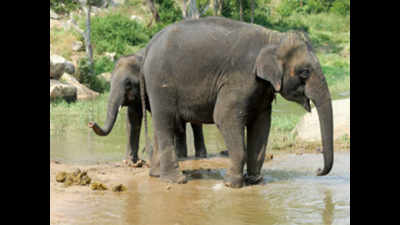- News
- City News
- bengaluru News
- Buoyed by Hassan success, forest dept to radio-collar more jumbos
Trending
This story is from September 11, 2019
Buoyed by Hassan success, forest dept to radio-collar more jumbos

Picture for representational purpose only.
BENGALURU: The forest department’s experiment to radio-collar select wild elephants in Hassan to track their movements and address conflict with humans has paid off. According to foresters, not a single incident of major injury or death of humans has been reported from the project area for almost a year.
Now, the department plans to try out the radio-collaring project in other conflict-prone regions.“We’ve seen good results in Hassan. We’re thinking of monitoring rogue elephants in Kodagu and other regions of Hassan as well using the same technology,” said Sanjay Mohan, principal chief conservator of forests (wildlife).
He said there are no plans to radio-collar wild elephants on Bengaluru’s outskirts for now. “Advance warning system using radio-collar mechanism is mainly to avoid human deaths. In Karnataka, Hassan and Kodagu are the most conflict-prone regions. While elephants from Bannerghatta do go on crop raids on the city’s outskirts and even go up to Tumakuru, the number of human casualties is not much,” Sanjay pointed out.
Karnataka has the highest number of elephants in the country — over 6,000 — and the growing numbers have resulted in increasing conflict with humans, thanks to shrinking habitat and other reasons.
The move came after elephant herds had become a major headache to villagers and foresters — they would raid standing crops, go on the rampage in coffee estates, trample paddy fields and devour banana and jackfruit.
A member of the state wildlife board welcomed the use of technology to tackle human-animal conflict. “But while replicating it in other regions, the department should keep in mind that technology is only a part of the process. A strong rapid action force to push the herds back into the forest and better coordination with villagers is equally important. Finally, we need long-term measures to restore elephant habitats, tackle deforestation and fragmentation of woods and restore continuity among forest regions,” he added.
How collar tech works?
Radio collar is an electronic module fitted with radio telemetric transmitter, which acquires GPS satellite position and forwards it within seconds to the server using local GSM networking
Tracker allows two-way communication; up to 20,000 positions can be stored and are not lost even if there is a GSM network failure
Weight of one elephant collar is around 10kg, which is 0.3-0.5 of the average body weight of an adult elephant
Collar is powered by imported lithium battery pack with 10-year guarantee.
Now, the department plans to try out the radio-collaring project in other conflict-prone regions.“We’ve seen good results in Hassan. We’re thinking of monitoring rogue elephants in Kodagu and other regions of Hassan as well using the same technology,” said Sanjay Mohan, principal chief conservator of forests (wildlife).
He said there are no plans to radio-collar wild elephants on Bengaluru’s outskirts for now. “Advance warning system using radio-collar mechanism is mainly to avoid human deaths. In Karnataka, Hassan and Kodagu are the most conflict-prone regions. While elephants from Bannerghatta do go on crop raids on the city’s outskirts and even go up to Tumakuru, the number of human casualties is not much,” Sanjay pointed out.
Karnataka has the highest number of elephants in the country — over 6,000 — and the growing numbers have resulted in increasing conflict with humans, thanks to shrinking habitat and other reasons.
AK Singh, chief conservator of forests, Hassan, recently said six mother elephants are being monitored in his jurisdiction for more than a year and three are radio-collared. “These elephants have a sub-population of 46 and roam the district in groups. The GPS-enabled radio telemetric transmitter gives real-time presence, activity pattern and movement of wild elephants. With such technology, foresters keep elephants at bay and villagers avoid entering their terrain,” he added.
The move came after elephant herds had become a major headache to villagers and foresters — they would raid standing crops, go on the rampage in coffee estates, trample paddy fields and devour banana and jackfruit.
A member of the state wildlife board welcomed the use of technology to tackle human-animal conflict. “But while replicating it in other regions, the department should keep in mind that technology is only a part of the process. A strong rapid action force to push the herds back into the forest and better coordination with villagers is equally important. Finally, we need long-term measures to restore elephant habitats, tackle deforestation and fragmentation of woods and restore continuity among forest regions,” he added.
How collar tech works?
Radio collar is an electronic module fitted with radio telemetric transmitter, which acquires GPS satellite position and forwards it within seconds to the server using local GSM networking
Tracker allows two-way communication; up to 20,000 positions can be stored and are not lost even if there is a GSM network failure
Weight of one elephant collar is around 10kg, which is 0.3-0.5 of the average body weight of an adult elephant
Collar is powered by imported lithium battery pack with 10-year guarantee.
End of Article
FOLLOW US ON SOCIAL MEDIA










